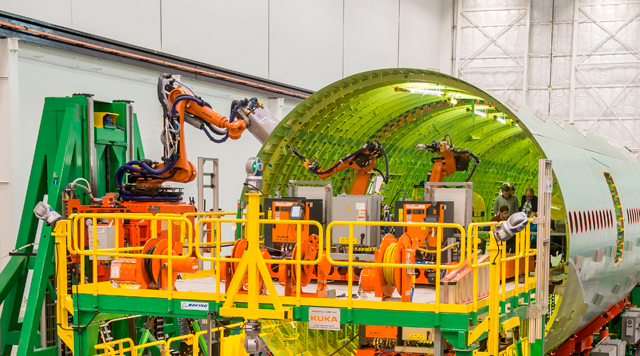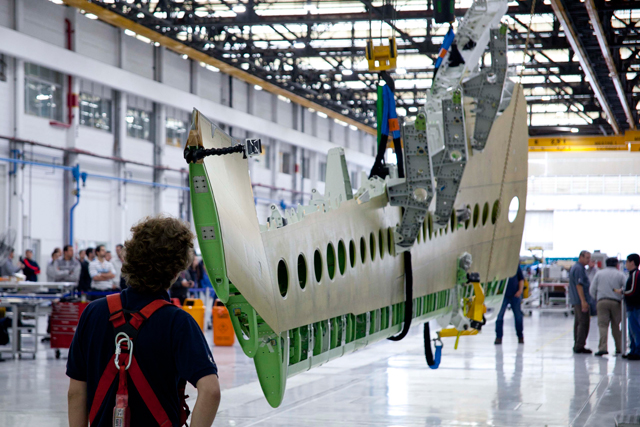Market demand is the reason Airbus and Boeing have announced plans to raise monthly aircraft deliveries by a combined 42% between now and 2020. Factory automation may be the key reason that aggressive ramp-up is possible.
At the centre of that automation ramp-up is a company called Electroimpact, of Mukilteo, Washington. Launched in 1986 with a new design for a handheld, low-voltage electro-magnetic riveting machine, the business now builds some of the industry’s most advanced automated assembly systems and robotic tools. Its iconoclastic founder-owner Peter Zieve has reached that stage using a management style that may seem more suited for a Silicon Valley start-up than an aerospace factory.
Electroimpact is transforming aircraft factories worldwide. Boeing’s widebody assembly centre in neighbouring Everett is a major user, but the company’s first customer was in the UK, where its machines help Airbus rivet wing panels for the A330 and A320. Electroimpact machines can also be found virtually anywhere aircraft are assembled. In Brazil, Embraer is using Electroimpact machines to assemble the wings of business jets and the second-generation E-Jet. In Canada, Bombardier outsourced complete design of the final assembly process for the Global 7000 business jet to Electroimpact.
The company’s capabilities are expanding as quickly as automated processes are penetrating new areas of aircraft assembly, and the shift from metals to composites in many aircraft structures presents a new opportunity. Boeing designed the automated fibre placement machines for the 787 more than a decade ago but looked to Electroimpact to improve their productivity. The launch of its 777X in 2013 yielded another chance to deploy a generational improvement in automation, using Electroimpact as a major supplier.
Compared to the 787’s 12in-wide tape lay-down systems, Boeing designed the fibre placement head for the 777X wing with a 30.5in-diameter, yielding what Electroimpact calls the largest and fastest automated fibre placement machine in the industry. The system was unveiled inside one of Electroimpact’s crowded production buildings in Mukilteo in early February, before being disassembled for transfer to Boeing’s emerging 777X factory complex a few miles away.
“That’s our biggest project,” says Zieve, offering a journalist a personal tour of the company’s facilities. “That’s going to be paying the bills.”
Electroimpact sourced a generic mould fixture from a nearby boat builder for $110,000 for the demonstration phase of the campaign. But the project has already progressed to building full-scale test articles. A completed, inboard section of a composite 777X wing box sat on a rolling cradle in an adjacent building.
When the 777-9 enters assembly in 2018, automation will have taken hold in the aerospace industry at a scale that would have seemed ambitious even a decade ago. While common in automotive factories, robots and automated assembly tools have struggled to compete with manual labour in the aerospace industry.
Zieve explains one of the key differences between automotive and aerospace applications on his personal tour, pointing to the seals around the door of his pickup truck.
“You can do that in automotive because the automation company will go to the sealant company and say, ‘I want a sealant that does this, this and this’. And the sealant company will say, ‘Sure, I can do that for you’,” Zieve says. “Well, in aerospace you cannot change the sealant one bit. It’s been flying 25 years and it hasn’t failed. You can’t change it [to suit the automation process]. They’re telling you, you have to use exactly that sealant – and it doesn’t work.”
An even more complex problem for automation systems is the accuracy demanded by aerospace structures. Tolerances of a tenth of a millimetre do not exist in mass-produced automotive parts.
“Automotive solutions were developed with automotive needs and challenges in mind. They were never developed to deal with aerospace challenges,” says Michael Assadi, an Electroimpact engineer, speaking at the Pacific Northwest Aerospace Alliance conference in Lynnwood, Washington on 11 February.
Electroimpact studied how to apply robotic arms commonly used to drill holes in automotive panels for aerospace. The arms developed by Kuka Technologies would work, but they would need a more advanced control system. Electroimpact selected a more sophisticated secondary controller developed by Siemens, and adapted it to the Kuka robotic system to meet the tolerances demanded by aerospace applications.

Composite structures offer new opportunities for automated assembly
Boeing
That formula has become Electroimpact’s mantra. It is not always necessary to develop everything from scratch. Instead it sees its role as identifying and understanding the interfaces and adaptations needed for aerospace parts, and to make those changes.
Another difference in the Electroimpact model is the management style. Zieve is a Massachusetts Institute of Technology-trained engineer with little patience for corporate formality. The company he founded in his garage now employs more than 600 engineers but he has no office and no assistant. He answers emails personally and – in this journalist’s experience – immediately.
Employees are hired and managed with the same direct, yet loose style. Every new engineer who joins the company is given their own purchasing account, rather than having to make requests through a central department.
“Every employee has the ability to spend money. We can go and buy whatever we want. If we get asked about it we have to justify it, and if we can justify it, it’s all good,” says Mark Sydenham, a controls engineer who joined Electroimpact out of university three years ago.
As there is no purchasing department, there is also no centralised service number for customers. They have the mobile phone numbers for the engineers who designed, built and delivered their machine. It is each engineer’s responsibility to support the machines they have already delivered, while working on new models for the next customer.
“There’s a lot of freedom for individuals to really sink or swim. There’s a lot of flexibility to go out on a limb, trying new things out,” Sydenham says. “I'm not told how to do it, but I’ve got to get it done. It’s got to work. And if it doesn’t work it’s on my shoulders.”
That approach has fuelled Electroimpact’s steady growth over three decades. The company has reached a point where an entrepreneur might think of selling, but not Zieve. He is not worried about lack of capital to fuel a new growth spurt.
“Why should [the company] get any bigger?” he asks. “I don’t have any shareholders. Screw them.”
Zieve says he has structured his ownership to make a sale legally impossible, even after he passes the company to his four sons.
“I won’t allow it to be sold. I don’t want my boys to sell it, and they won’t sell it anyway. I want it to be a family business [in] perpetuity,” he says.
Electroimpact is still expanding its reach. The company started with handheld riveters [see below], then steadily progressed to drilling wing panels, assembling complete metal wings and automated fibre placement. Zieve wants to develop a form of automation for fuselage structures that has become a speciality of competitor Broetje Automation. A new C-yoke squeezer riveting machine now sits in testing in one of Electroimpact’s buildings before being delivered to Fuji Heavy Industries. In some ways, the move is a step backward in the automation business, returning to a technology in use before Zieve conceived of low-voltage electromagnetic riveters.
“I like the counter-intuitive part. That appeals to me,” Zieve says. “But it’s hard to explain. Electroimpact was going in a different direction, and I said, ‘No, we need to go in this direction,’ and so I am enjoying that. And it’s working out. We’ll get there. We’re still new babes in the woods.”
THE STORY OF ELECTROIMPACT'S FIRST INVENTION
Installing the humble rivet is still one of the most labour-intensive processes in aerospace manufacturing. Usually made of aluminium or titanium alloy, these short metal pins with a head at one end are used to fasten skins and spars to interior subassemblies. A hole is drilled, and a rivet is driven into the opening. On the other side, the end of the pin meets an anvil-inspired structure called a bucking plate with so much force that it “upsets”, or spreads to become a flat plate that locks the pin firmly into place.
The most common way of installing such a rivet involves a highly-trained team of two labourers – one for drilling the pin using a pneumatic-powered riveter, and another on the other side for applying back-pressure with a bucking plate. But pneumatic-powered riveters, besides being labour-intensive, are also noisy and prone to normal human variations in accuracy and quality. An automated system known as a C-yoke squeezer can be used, but such machines are so large and complex that they are limited to only the longest, continuous structures.
By the early 1980s, Boeing and other manufacturers had figured out a way to use electromagnetic effects for the purpose of installing rivets. They used a principle structural engineers had already applied to cold-forming sheet metal. A bank of high-voltage capacitors produces an intense magnetic pulse, activating a magnetic field around a coil placed against a workpiece which accelerates at hyper-speed onto a die. The force of the die against the sheet transforms the shape of the metal. By attaching a riveter to the die, the same effect could install a rivet in the blink of an eye. Moreover, the force and speed of the machine could always be controlled, reducing the rate of errors compared to manual drilling.

Wing assembly is well-suited to automation
Embraer
But there were also problems caused by using this approach. The high-voltage of the equipment was a particular concern. Any equipment using more than 600VDC requires special handling, creating safety concerns for the human operators. The high-voltage electromagnetic riveters typical in the 1980s commonly used 10kVDC. Such a powerful electric current imparted sufficient force to hammer in the rivet, but there was a cost. The acceleration of the workpiece into the die was so fast that it could cause some types of rivet heads to crack.
By the mid-1980s, Boeing was looking for alternatives to high-voltage riveting machines, including funding a study by a professor at the University of Washington. It happened that Zieve had just arrived at the university to continue the graduate studies he began at the Massachusetts Institute of Technology. When he heard about the Boeing-funded study, it revived a distant memory from his undergraduate days at MIT.
While looking for a physics professor, he entered the wrong room. Zieve found another student working on a Tokamak, a small device used to generate nuclear fusion. The device caught his attention, especially the energy storage mechanism.
“I looked at the set up and I remember [thinking], ‘Whoa,’”, Zieve recalls. “I said to him, ‘Does that work? Can you create fusion with electrolytic capacitors?’ He said, ‘It works fine.’”
The exchange lasted only a moment before Zieve left the room, continuing his search for the physics professor. A decade later, another professor at the University of Washington was describing Boeing’s need for low-voltage electromagnetic riveting. In a second, Zieve connected the electrolytic capacitor to the problem.
“I just put the two together. [The MIT student had] said, ‘It works fine’,” Zieve says. “I decided that was going to be my career right there.”
With the use of electrolytic capacitors for energy storage and a thicker copper plate to actuate the workpiece, Zieve had invented the handheld low-voltage electromagnetic riveter in 1986. The entire system requires no more than 500VDC. The magnetic pulse is softer, reducing the acceleration of the die into the rivet, thereby reducing the chance of cracking.
Surprisingly, it took Boeing another decade to put Electroimpact on contract. But Airbus was quick to embrace the technology for riveting wing panels on its A330. The rest, of course, is history.
Source: FlightGlobal.com























